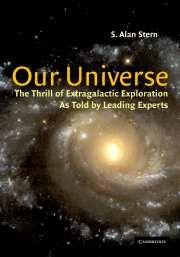Book contents
- Frontmatter
- Contents
- Preface
- The frontier Universe: At the edge of the night
- Part I Revealing a Universe
- Part II Denizens of the deep
- 5 The search for very massive black holes
- 6 Gamma-ray bursts—the most spectacular fireworks
- 7 Clusters of galaxies and the fate of the Universe (Or how to be a cosmologist without really trying)
- 8 Dark matter and the discovery of galactic halos
- 9 Hunting the elusive invisible galaxy
- Plate section
6 - Gamma-ray bursts—the most spectacular fireworks
Published online by Cambridge University Press: 03 September 2009
- Frontmatter
- Contents
- Preface
- The frontier Universe: At the edge of the night
- Part I Revealing a Universe
- Part II Denizens of the deep
- 5 The search for very massive black holes
- 6 Gamma-ray bursts—the most spectacular fireworks
- 7 Clusters of galaxies and the fate of the Universe (Or how to be a cosmologist without really trying)
- 8 Dark matter and the discovery of galactic halos
- 9 Hunting the elusive invisible galaxy
- Plate section
Summary
Bohdan Paczyński was raised and educated in Poland. He came to Princeton University's Astronomy Department in United States in 1982, where he holds the Lyman Spitzer professorship. Bohdan has held visiting positions in major astronomical institutions around the world, including Caltech, Cambridge, Harvard, Paris, and Moscow. This distinguished thinker and theoretician has been awarded numerous prizes for his contributions to astronomy, including the Gold Medal of the Royal Astronomical Society in London, the Henry Draper Medal of the US National Academy of Sciences, and the Eddington Medal of the Royal Astronomical Society. For over a decade now, he has concentrated much of his research in the study of one of the Universe's most challenging and enigmatic astrophysical phenomena: the bright, high-energy gamma-ray flashes known astro-colloquially as gamma-ray bursts.
Gamma-ray bursts (GRBs) were discovered with four US military spacecraft: Vela 5A, 5B, 6A, and 6B, launched in the late 1960s to monitor Soviet compliance with the nuclear test ban treaty. While first bursts were recorded in July of 1969, it took several years to develop proper software to uncover them from a huge volume of data, and the discovery paper by Ray W. Klebesadel, Ian B. Strong and Roy A. Olson of the Los Alamos Scientific Laboratory was published in The Astrophysical Journal on June 1, 1973. This became instant headline news for the astronomical community.
- Type
- Chapter
- Information
- Our UniverseThe Thrill of Extragalactic Exploration, pp. 89 - 106Publisher: Cambridge University PressPrint publication year: 2001

